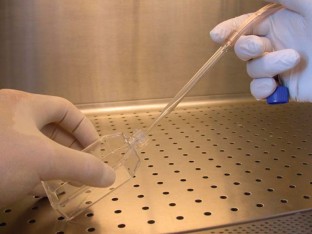Abstract
Cell lines are widely used in biomedical research. This protocol describes the methods used routinely to change the medium and passage the cells. Medium changes keep the cells healthy by providing fresh nutrients, while cell passage or splitting is required to maintain cells in exponential growth. Despite the simplicity of the methods used, each cell line has idiosyncracies. Whether working with one or several cell lines, there is no substitute for knowledge of their needs, including the range of phenotypes and growth patterns under different physical and nutrient conditions. Given the necessary care and attention, most cell lines are easy to maintain and grow.
This is a preview of subscription content, access via your institution
Access options
Subscribe to this journal
Receive 12 print issues and online access
$259.00 per year
only $21.58 per issue
Buy this article
- Purchase on Springer Link
- Instant access to full article PDF
Prices may be subject to local taxes which are calculated during checkout

Similar content being viewed by others
References
Schaeffer, W.I. Usage of vertebrate, invertebrate and plant cell, tissue and organ culture terminology. In Vitro 20, 19–24 (1984).
Freshney, R.I. (ed.) Culture of Animal Cells 4th edn. (Wiley Liss, New York, 2000).
Southam, C.M. Homotransplantation of human cell lines. Bull NY Acad. Med. 34, 416–423 (1958).
Gugel, E.A. & Sanders, M.E. Needle-stick transmission of human colonic adenocarcinoma. N. Engl. J. Med. 315, 1487 (1986).
Lloyd, G. & Jones, N. Infection of laboratory workers with hantavirus acquired from immunocytomas propagated in laboratory rats. J. Infect. 12, 117–125 (1984).
Tedder, R.S. et al. Hepatitis B transmission from a contaminated cryopreservation tank. Lancet 346, 137–140 (1995).
Hummeler, K., Davidson, W.L., Henle, W., LaBoccetta, A.C. & Ruch, H.G. Encephalomyelitis due to infection with Herpesvirus simiae (Herpes B virus); a report of two fatal, laboratory-acquired cases. N. Engl. J. Med. 261, 64–68 (1959).
UKCCCR. UKCCCR guidelines for the use of cell lines in cancer research. Br. J. Cancer 82, 1495–1509 (2000).
Coecke, S. et al. Guidance on good cell culture practice. Altern Lab Anim 33, 261–287 (2005).
Acknowledgements
We thank Ian Freshney for reading and commenting on this set of protocols.
Author information
Authors and Affiliations
Corresponding author
Ethics declarations
Competing interests
The authors declare no competing financial interests.
Rights and permissions
About this article
Cite this article
Masters, J., Stacey, G. Changing medium and passaging cell lines. Nat Protoc 2, 2276–2284 (2007). https://doi.org/10.1038/nprot.2007.319
Published:
Issue Date:
DOI: https://doi.org/10.1038/nprot.2007.319
Comments
By submitting a comment you agree to abide by our Terms and Community Guidelines. If you find something abusive or that does not comply with our terms or guidelines please flag it as inappropriate.



